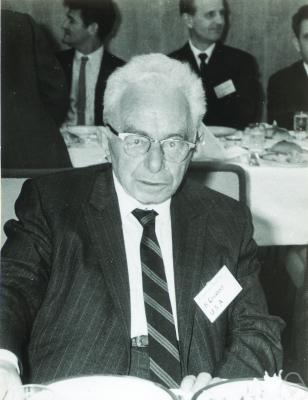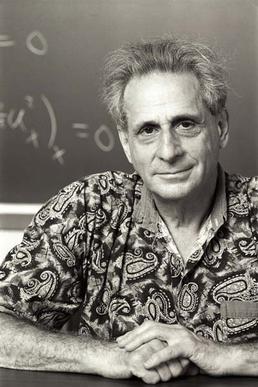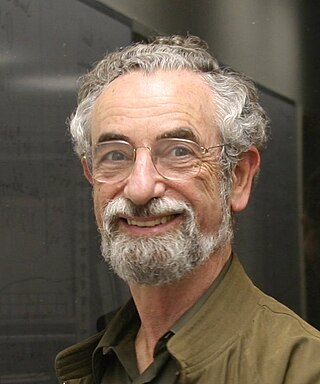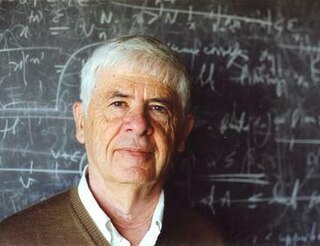Related Research Articles
In physics, statistical mechanics is a mathematical framework that applies statistical methods and probability theory to large assemblies of microscopic entities. It does not assume or postulate any natural laws, but explains the macroscopic behavior of nature from the behavior of such ensembles.

Josiah Willard Gibbs was an American scientist who made significant theoretical contributions to physics, chemistry, and mathematics. His work on the applications of thermodynamics was instrumental in transforming physical chemistry into a rigorous inductive science. Together with James Clerk Maxwell and Ludwig Boltzmann, he created statistical mechanics, explaining the laws of thermodynamics as consequences of the statistical properties of ensembles of the possible states of a physical system composed of many particles. Gibbs also worked on the application of Maxwell's equations to problems in physical optics. As a mathematician, he invented modern vector calculus.

Mathematical physics refers to the development of mathematical methods for application to problems in physics. The Journal of Mathematical Physics defines the field as "the application of mathematics to problems in physics and the development of mathematical methods suitable for such applications and for the formulation of physical theories". An alternative definition would also include those mathematics that are inspired by physics.

Richard Courant was a German American mathematician. He is best known by the general public for the book What is Mathematics?, co-written with Herbert Robbins. His research focused on the areas of real analysis, mathematical physics, the calculus of variations and partial differential equations. He wrote textbooks widely used by generations of students of physics and mathematics. He is also known for founding the institute now bearing his name.

Sir Edmund Taylor Whittaker was a British mathematician, physicist, and historian of science. Whittaker was a leading mathematical scholar of the early 20th-century who contributed widely to applied mathematics and was renowned for his research in mathematical physics and numerical analysis, including the theory of special functions, along with his contributions to astronomy, celestial mechanics, the history of physics, and digital signal processing.

Martin David Kruskal was an American mathematician and physicist. He made fundamental contributions in many areas of mathematics and science, ranging from plasma physics to general relativity and from nonlinear analysis to asymptotic analysis. His most celebrated contribution was in the theory of solitons.

Cornelius (Cornel) Lanczos was a Hungarian-Jewish, Hungarian-American and later Hungarian-Irish mathematician and physicist. According to György Marx he was one of The Martians.

Elliott Hershel Lieb is an American mathematical physicist and professor of mathematics and physics at Princeton University who specializes in statistical mechanics, condensed matter theory, and functional analysis.

Nikolay Nikolayevich Bogolyubov, also transliterated as Bogoliubov and Bogolubov, was a Soviet and Russian mathematician and theoretical physicist known for a significant contribution to quantum field theory, classical and quantum statistical mechanics, and the theory of dynamical systems; he was the recipient of the 1992 Dirac Medal.
The classical-map hypernetted-chain method is a method used in many-body theoretical physics for interacting uniform electron liquids in two and three dimensions, and for non-ideal plasmas. The method extends the famous hypernetted-chain method (HNC) introduced by J. M. J van Leeuwen et al. to quantum fluids as well. The classical HNC, together with the Percus–Yevick approximation, are the two pillars which bear the brunt of most calculations in the theory of interacting classical fluids. Also, HNC and PY have become important in providing basic reference schemes in the theory of fluids, and hence they are of great importance to the physics of many-particle systems.
Applied mechanics is the branch of science concerned with the motion of any substance that can be experienced or perceived by humans without the help of instruments. In short, when mechanics concepts surpass being theoretical and are applied and executed, general mechanics becomes applied mechanics. It is this stark difference that makes applied mechanics an essential understanding for practical everyday life. It has numerous applications in a wide variety of fields and disciplines, including but not limited to structural engineering, astronomy, oceanography, meteorology, hydraulics, mechanical engineering, aerospace engineering, nanotechnology, structural design, earthquake engineering, fluid dynamics, planetary sciences, and other life sciences. Connecting research between numerous disciplines, applied mechanics plays an important role in both science and engineering.
Engineering mathematics is a branch of applied mathematics concerning mathematical methods and techniques that are typically used in engineering and industry. Along with fields like engineering physics and engineering geology, both of which may belong in the wider category engineering science, engineering mathematics is an interdisciplinary subject motivated by engineers' needs both for practical, theoretical and other considerations outside their specialization, and to deal with constraints to be effective in their work.

Jerrold Eldon Marsden was a Canadian mathematician. He was the Carl F. Braun Professor of Engineering and Control & Dynamical Systems at the California Institute of Technology. Marsden is listed as an ISI highly cited researcher.

Alexandre Joel Chorin is an American mathematician known for his contributions to computational fluid mechanics, turbulence, and computational statistical mechanics.
In statistical mechanics the Percus–Yevick approximation is a closure relation to solve the Ornstein–Zernike equation. It is also referred to as the Percus–Yevick equation. It is commonly used in fluid theory to obtain e.g. expressions for the radial distribution function. The approximation is named after Jerome K. Percus and George J. Yevick.

Applied mathematics is the application of mathematical methods by different fields such as physics, engineering, medicine, biology, finance, business, computer science, and industry. Thus, applied mathematics is a combination of mathematical science and specialized knowledge. The term "applied mathematics" also describes the professional specialty in which mathematicians work on practical problems by formulating and studying mathematical models.

Harold Grad was an American applied mathematician. His work specialized in the application of statistical mechanics to plasma physics and magnetohydrodynamics.

Alexander Nikolaevich Gorban is a scientist of Russian origin, working in the United Kingdom. He is a professor at the University of Leicester, and director of its Mathematical Modeling Centre. Gorban has contributed to many areas of fundamental and applied science, including statistical physics, non-equilibrium thermodynamics, machine learning and mathematical biology.

Lectures on Theoretical Physics is a six-volume series of physics textbooks translated from Arnold Sommerfeld's classic German texts Vorlesungen über Theoretische Physik. The series includes the volumes Mechanics, Mechanics of Deformable Bodies, Electrodynamics, Optics, Thermodynamics and Statistical Mechanics, and Partial Differential Equations in Physics. Focusing on one subject each semester, the lectures formed a three-year cycle of courses that Sommerfeld repeatedly taught at the University of Munich for over thirty years. Sommerfeld's lectures were famous and he was held to be one of the greatest physics lecturers of his time.
References
- ↑ "Obituaries | Columbia College Today". college.columbia.edu. Retrieved 2022-03-18.
- ↑ Jerome K. Percus, George J. Yevick (1958), "Analysis of Classical Statistical Mechanics by Means of Collective Coordinates", Physical Review (in German), vol. 110, no. 1, pp. 1-13, doi:10.1103/PhysRev.110.1